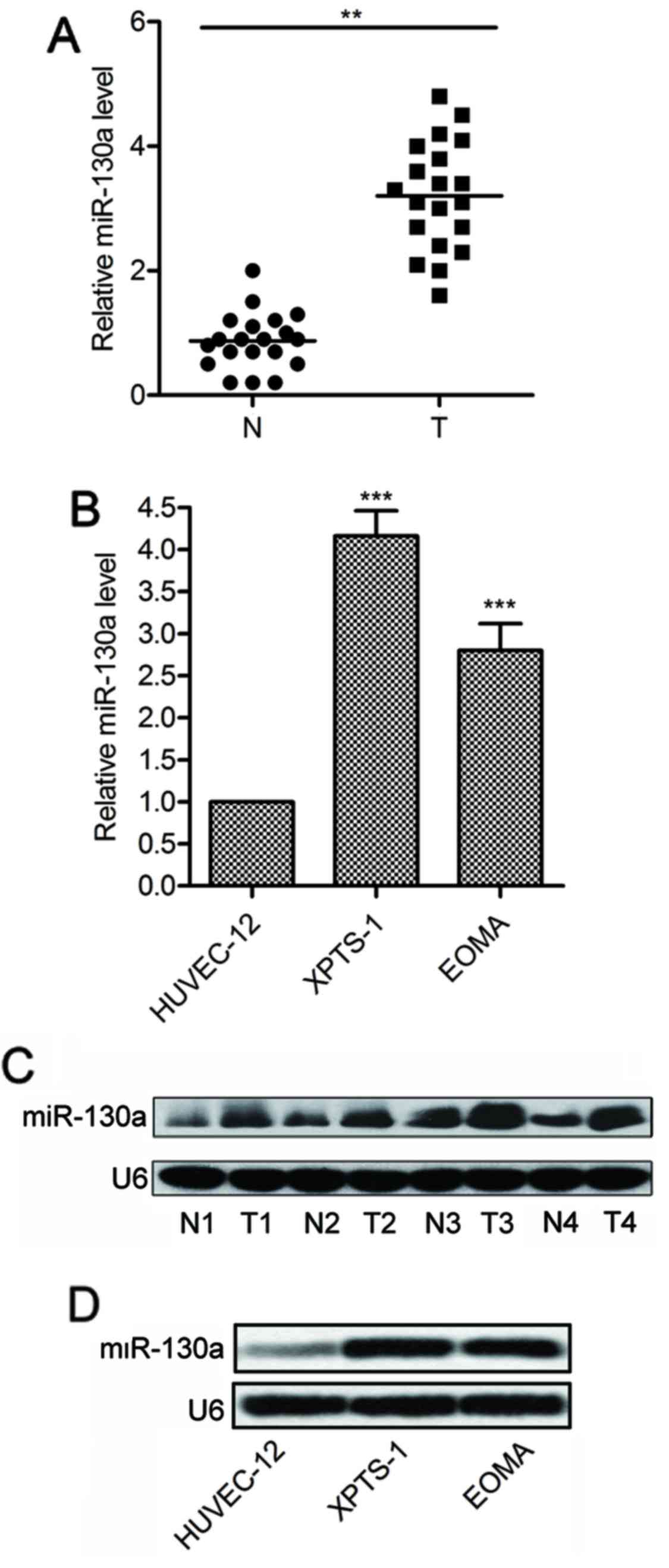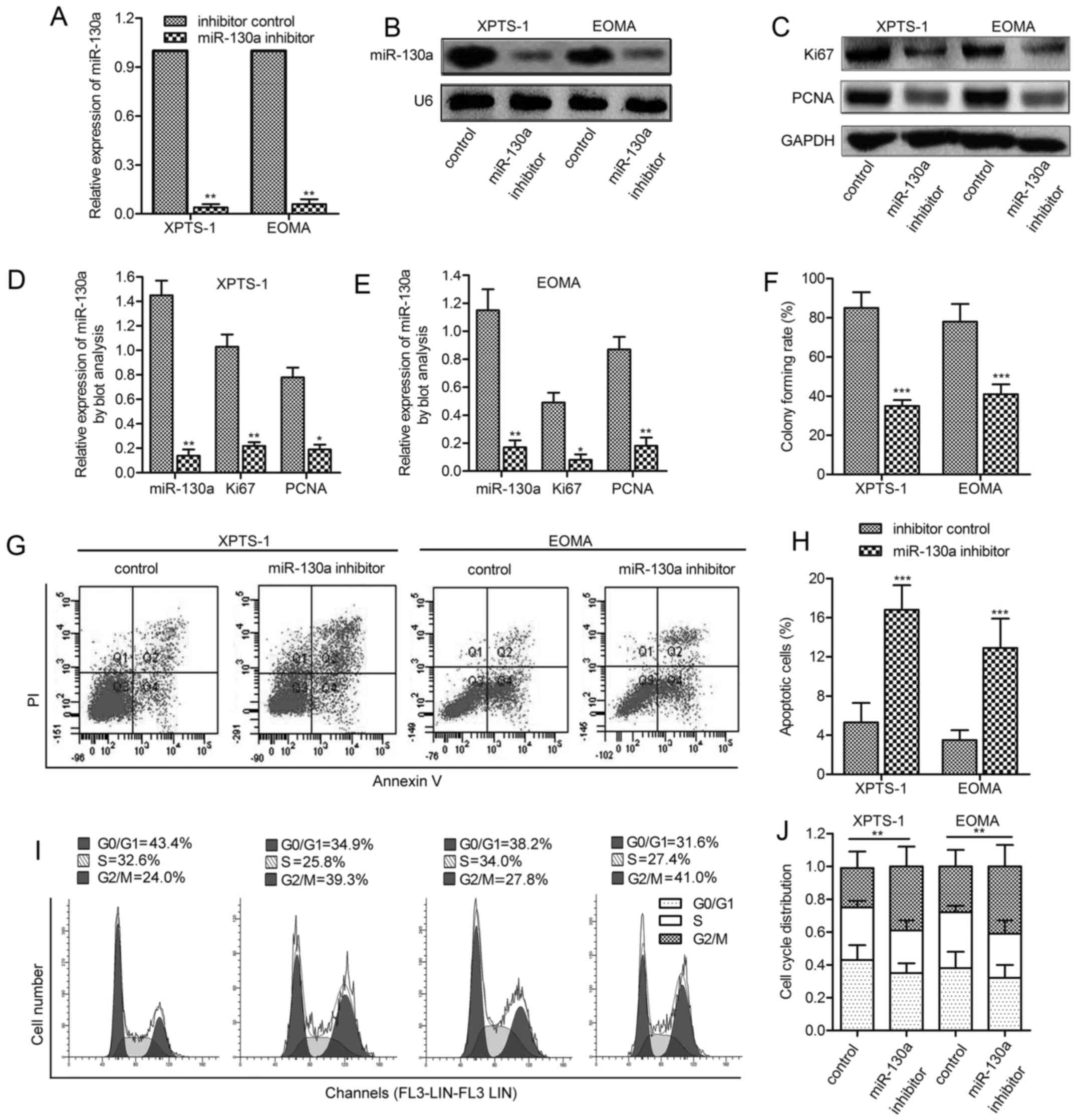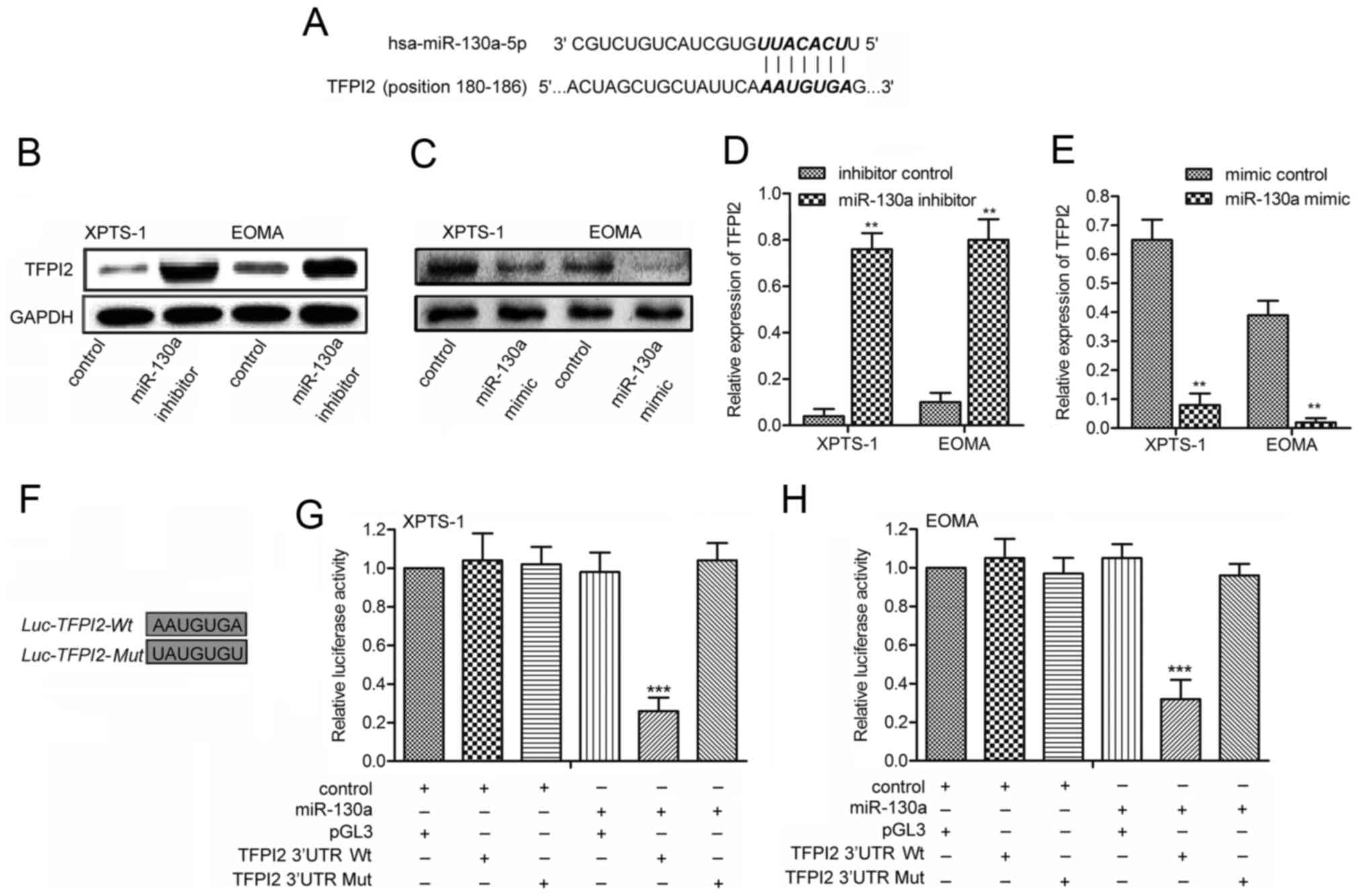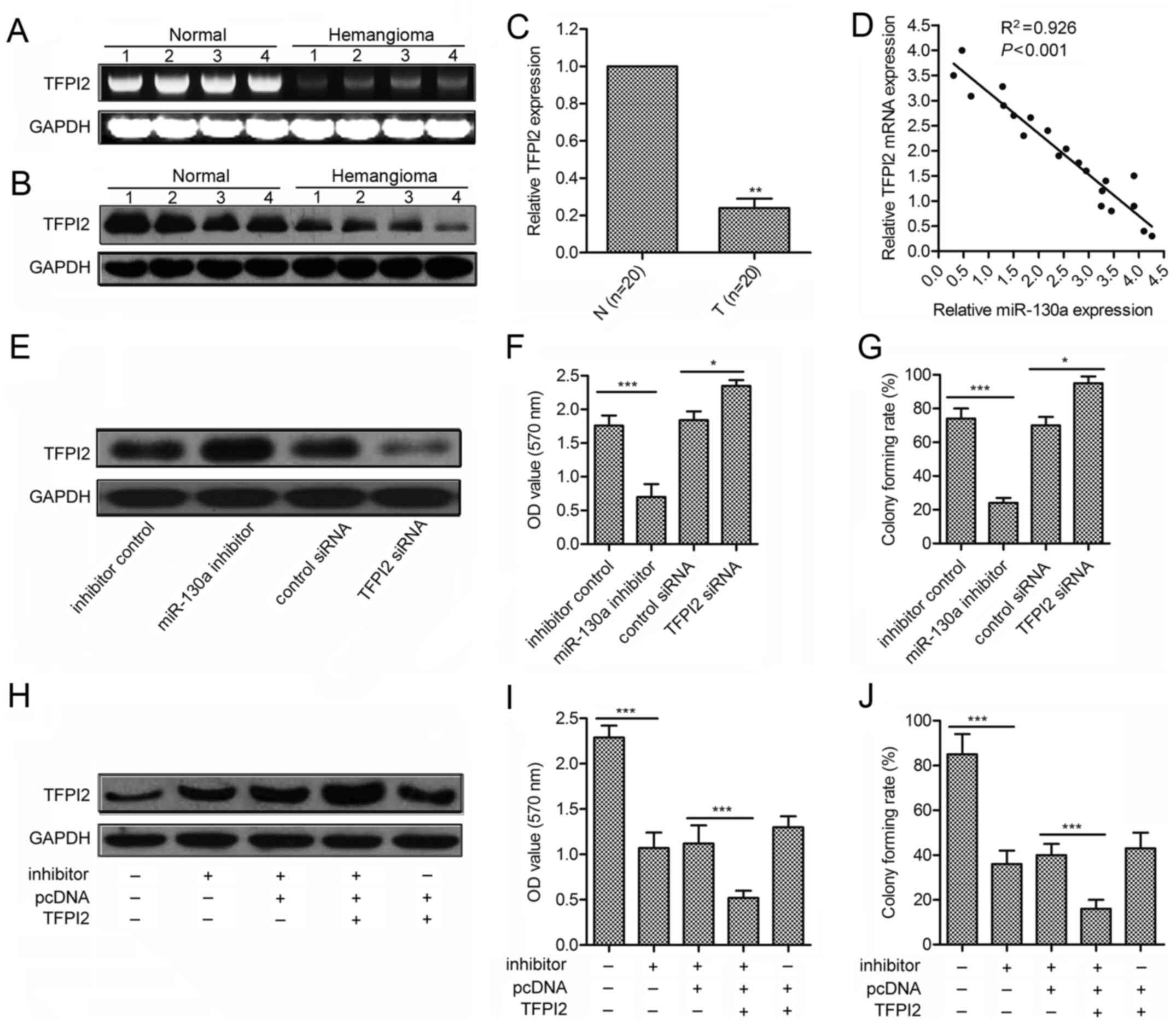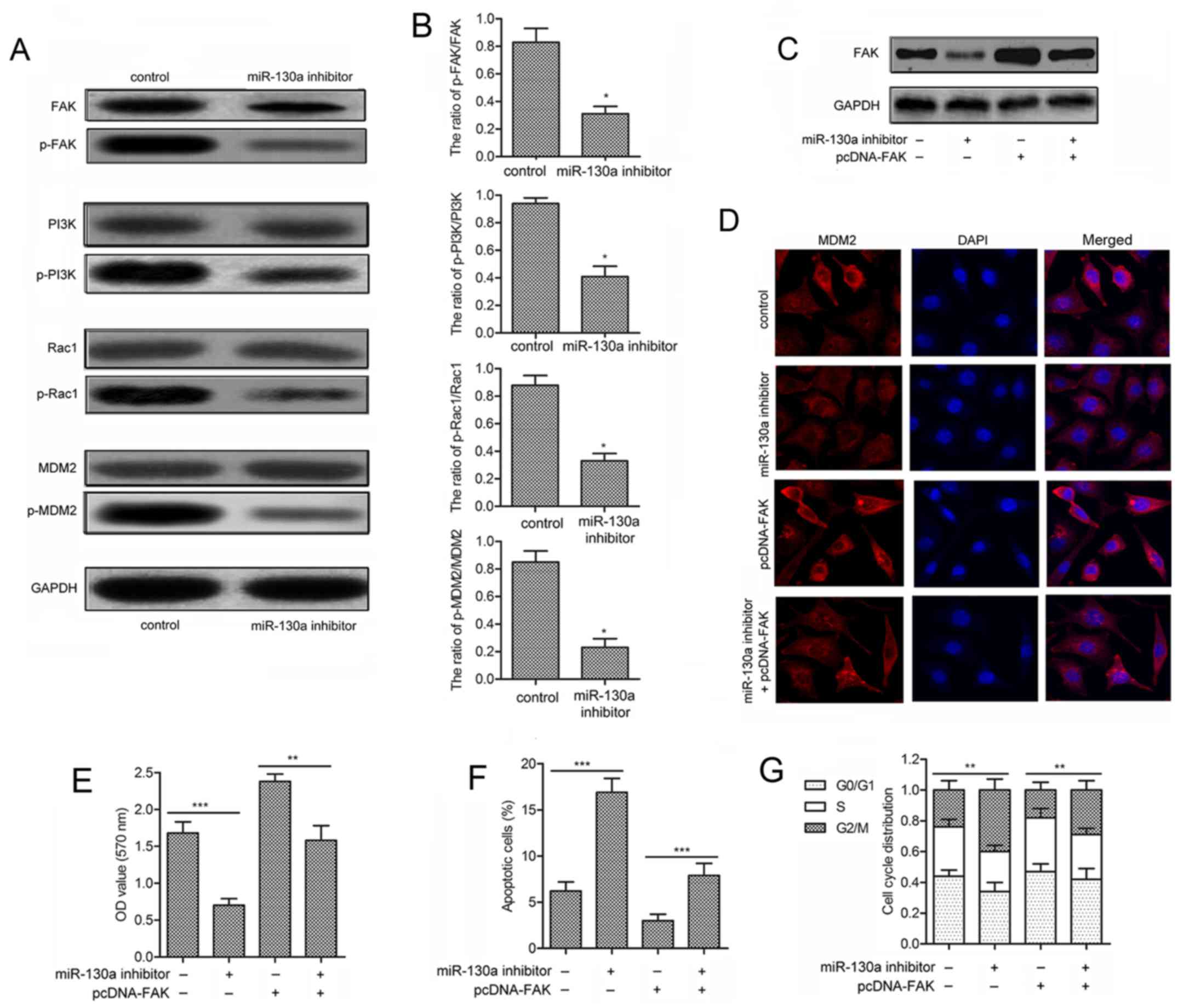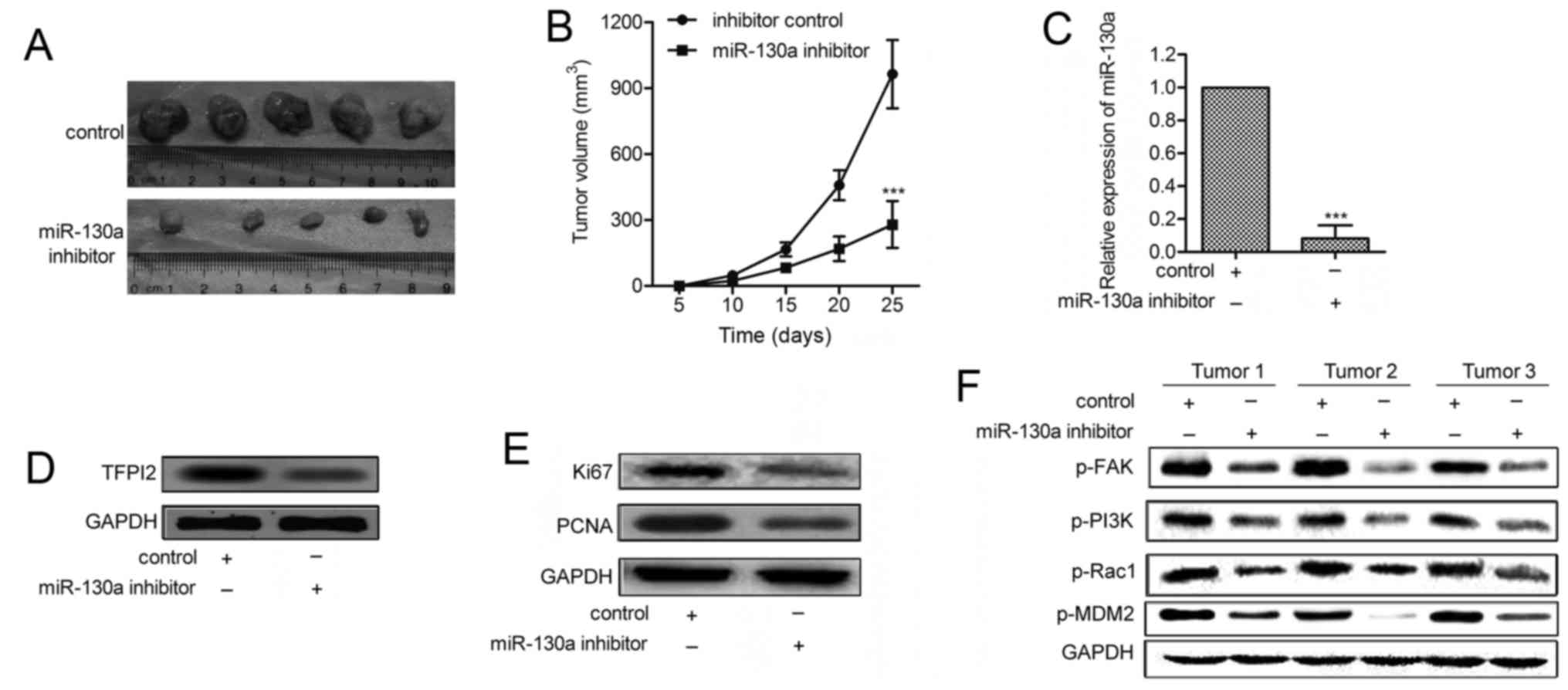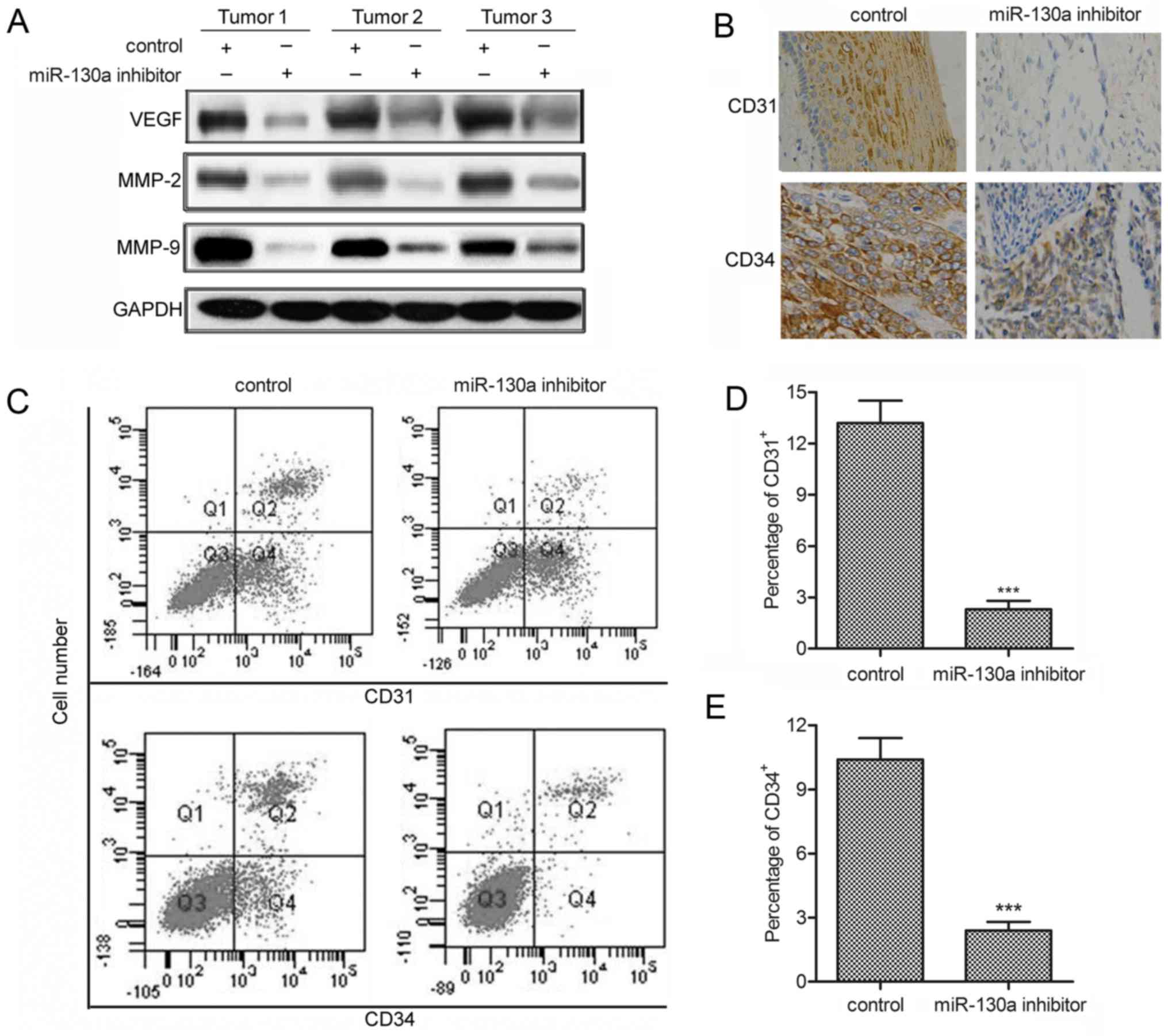Epigenetic silencing of miR-130a ameliorates hemangioma by targeting tissue factor pathway inhibitor 2 through FAK/PI3K/Rac1/mdm2 signaling
- Authors:
- Published online on: April 3, 2017 https://doi.org/10.3892/ijo.2017.3943
- Pages: 1821-1831
Abstract
Introduction
Infantile hemangioma (IH) is a common benign tumor in childhood, and more frequent in prematures and low birth weight infants (1). IH has three distinctive clinical and histological phases: an initial proliferative phase with rapid growth and undeveloped blood channels, a plateau and the final involuted phase with scattered capillaries and large draining vessels (2). IH is characterized by the spontaneous regression of blood vessels. IHs are disfiguring in some cases, which is also the leading cause of morbidity in affected children (2,3). Recently, advances have been made in the treatment of IH with clear curative effect, such as propranolol (4), nadolol (5) and pulsed dye laser (6). However, the main clinical problem is still the lack of reliable parameters to treat IH lesions in patients. Therefore, the identification of genetic and epigenetic alterations in IH lesions will help to establish molecular mechanisms of this desease.
In recent years, miRNAs are considered as ideal biomarkers for cancer identification, for the properties that miRNAs are highly conserved in the genome and have a relatively high degree of tissue specificity (7). Abnormal expression of miRNAs is deeply associated with numerous pathological processes, such as angiogenesis (8), carcinogenesis (9) and inflammation (10). The microRNA (miR)-130 family is composed of miR-130b, miR-301a and miR-301b, which share a common seed sequence (9). miR-130a is located at chromosome 11q12, close to the 11q13 area (11). miR-130a has been found to be involved in multiple types of human diseases, including gastric (12), cervical cancer (13), chronic myeloid leukemia (14) and metabolism-related inflammation (15). Besides, reports indicate that miR-130a promote the proliferation, migration and tube formation of vascular endothelial cells (16). However, the comprehensive effect of the miR-130a on tumor progression of hemangioma has not been analyzed.
Tissue factor pathway inhibitor 2 (TFPI2) is secreted as a glycosylated protein with a short acidic amino-terminal region, three tandem Kunitztype domains and a carboxy-terminal tail (17). TFPI2 belongs to a Kunitz family of serine protease inhibitors that contain one or more Kunitz-type domains. The family has more than 20 members including pancreatic trypsin inhibitor (aprotinin) and the homolog of TFPI2 (18). A report indicated that human TFPI2 was first identified in the placenta to inhibit the amidolytic activity of plasmin (19). Recent reports suggested that the downregulation were associated with the development of multiple deseases, including atherosclerotic plaque (20), pancreatic carcinoma (21), hepatocellular carcinoma (22) and cervical cancer (23). Considering TFPI2 is secreted into the extracellular matrix (ECM) to help regulate ECM remodeling, the role of TFPI2 involved in hemangioma is worthy of investigation.
The present study explored the expression of miR-130a in hemangioma tissues and cell lines. We found that the inhibition of miR-130a effectively suppressed the growth of hemangioma by targeting TFPI2 and inactivating focal adhesion kinase (FAK)/phosphoinositide 3-kinase (PI3K)/Rac1/anti-mouse double minute (mdm2) pathway. This study also revealed an inhibitory effect of angiogenesis via downregulating miR-130a.
Materials and methods
Hemangioma samples
Twenty pairs of human hemangioma and adjacent normal tissues were obtained from Shandong Provincial Hospital Affiliated to Shandong University (Shandong, China). The tissues were frozen in liquid nitrogen and stored at −80°C until use. Written informed consent for tissue donation (for research purposes) was obtained from the patients, and the protocol was approved by the Institutional Review Board of the Provincial Affiliated Hospital of the Shandong University.
Cell lines
The human vascular endothelial HUVEC-12 cells, human IH cell lines XPTS-1 and mouse hemangioendothelioma cells (EOMA) were obtained from the American Type Culture Collection (ATCC; Manassas, VA, USA). These cell lines were cultured in Dulbecco's modified eagle's medium (DMEM) plus 10% fetal bovine serum (FBS; Life Technologies, Inc., Grand Island, NY, USA) and grown at 37°C in a 5% CO2 atmosphere.
Quantitative real-time polymerase chain reaction (qRT-PCR)
The total RNA was extracted from TRIzol reagent (Invitrogen, Carlsbad, CA, USA) following the manufacturer's instructions. The RT-PCR primers for miR-130a and U6 were purchased from GeneCopoeia, Inc. (San Diego, CA, USA). The PCR primers for TFPI2 were: forward, 5′-GTCGATTCTGCTGCTTTTCC-3′ and reverse, 5′-ATGGAATTTTCTTTGGTGCG-3′ (440 bp) (24). GAPDH and U6 SnRNA were used as the internal control of the mRNA or miRNA, respectively. Fold-change of miR-130a was calculated by the 2−ΔΔCt method.
Northern blot analysis
The expression levels of miR-130a in hemangioma samples, adjacent normal tissues, HUVEC-12, XPTS-1 and EOMA cells were further determined by northern blot assay according to previously described procedures (25).
The transfection of miR-130a mimic/inhibitor
The miR-130a mimic, negative control of miRNA mimic, miR-130a inhibitor and negative control of miRNA inhibitor were purchased from Shanghai GenePharma, Co., Ltd. (Shanghai, China), and transfected into XPTS-1 and EOMA cells at a final concentration of 100 nM with Lipofectamine 2000 (Invitrogen) according to the manufacturer's instructions. After 6 h, the cells were returned to normal medium and cultured for an additional 48 (for RNA isolation) or 72 h (for protein extraction).
Colony formation assay
XPTS-1 and EOMA cells were transfected with miR-130a inhibitor or control. After 48 h of infection, the cells were plated in 6-well plates at 200/well and grown for 2 weeks. Then, the cells were washed twice with phosphate-buffered saline (PBS), fixed with methanol/acetic acid (3:1, vol/vol) and stained with 0.5% crystal violet. The number of colonies was counted under the microscope.
Cell apoptosis assay and cell cycle analysis
XPTS-1 (5×103) and EOMA cells were plated into each well of 96-well plates, respectively. Six hours later, the cells were treated with miR-control or miR-130a inhibitor. The procedures of cell cycle analysis were previously described (21). Cell numbers were determined by Scepter™ 2.0 Handheld Automated Cell Counter.
Western blotting
Cell samples were lysed in lysis buffer (Beyotime Institute of Biotechnology, Haimen, China). The samples mixed with loading buffer were incubated in boiling water for 10 min. Protein (20–30 µg) was separated through SDS-PAGE and then transferred onto polyvinylidene fluoride (PVDF) membranes (Millipore, Billerica, MA, USA). The following primary antibodies were used: anti-TFPI2, anti-Ki-67, anti-proliferating cell nuclear antigen (PCNA), anti-FAK, anti-PI3K, anti-Rac1, anti-mdm2, anti-p-FAK, anti-p-PI3K, anti-p-Rac1, anti-p-mdm2, anti-vascular endothelial growth factor (VEGF), anti-matrix metalloproteinase (MMP)-2, anti-MMP-9 and anti-GAPDH (Abcam, Hangzhou, China), which was used as the internal reference. After incubation with the appropriate horseradish peroxidase (HRP)-conjugated secondary antibody, proteins were detected using a ChemiDoc XRS imaging system and quantity One analysis software (Bio-Rad Laboratories, San francisco, CA, USA).
Luciferase reporter assay
The cDNA of TFPI2 was amplified by PCR, and general method of recombinant DNA was used to clone the wild-type (WT) 3′-UTR and mutant (MUT) 3′-UTR of TFPI2. The WT and MUT sequences of TFPI2 were then cloned into a pMIR-Report luciferase reporter vector (Ambion, Austin, TX, USA) to generate constructs of Luc-TFPI2 and Luc-TFPI2-mut, followed by DNA sequencing verification. The pMIR-Report control vector (Luc-control) was also cloned. All three vectors were transfected into XPTS-1 cells/EOMA cells in 6-well plates with a Lipofectamine 2000 reagent kit (Sigma-Aldrich, St. Louis, MO, USA). After 1 day, the luciferase activity was measured using a luciferase reporter assay system (Promega, Madison, WI, USA). All relative luciferase activities were normalized to the condition of Luc-control with β-galactosidase transfection.
siRNA transfection
The small interfering RNA (siRNA), to genetically downregulate TFPI2 (TFPI2-siRNA), as well as its non-specific scramble siRNA (NC-siRNA), were purchased from Guangzhou RiboBio, Co., Ltd. (Guangzhou, China). Transfection of siRNAs into XPTS-1 cells was conducted using Lipofectamine 2000 reagent kit. In XPTS-1 cells, 100 nM siRNAs (TFPI2-siRNA and NC-siRNA) were used. The efficiency of siRNA interference was confirmed by western blot analysis 48 h after transfection.
Overexpression of TFPI2 and FAK
TFPI2 and FAK overexpression was achieved by PCR amplification using their cDNA as templates, separately, and the TFPI2 and FAK expressing vectors were constructed by inserting their cDNA into pcDNA 3.1 vector (Sigma-Aldrich). The recombinant plasmids and other agents were co-transfected into 3×106 XPTS-1 cells using a Nucleofector instrument. Forty-eight hours later, subsequent experiments were performed on the cells. The experiment was replicated thrice for data calculations.
Immunofluorescence staining
Fluorescent cells were cultured on an 8-well chamber culture slides (Becton-Dickinson, Bedford, MA, USA). After 8 h, cells were fixed in 3% paraformaldehyde in PBS at room temperature for 8 min, then permeabilized with 0.2% Triton X-100 for 15 min at room temperature. After washing in PBS, the cells were incubated with primary mouse anti-FAK monoclonal antibody (1 mg/ml; Transduction Laboratories, Lexington, KY, USA) at 4°C overnight. After washing, cells were incubated with biotinylated goat anti-mouse IgG (Pierce, Rockford, IL, USA) at room temperature for 1 h. The immunoreactivity was revealed using Alexa568-conjugated streptavidin (Molecular Probes, Eugene, OR, USA) and cells were counterstained with 10 mg/ml DAPI. The cells were examined under a Nikon fluorescence microscope (Image Systems, Columbia, MD, USA).
Hemangioma xenografts
Male athymic nude mice were housed and manipulated according to the protocols approved by the Experimental Animal Center of the Shandong Provincial Hospital Affiliated to Shandong University. For each mouse, 5×106 miR-130a-inhibiting XPTS-1 cells were injected subcutaneously into the right scapula in 100 serum-free medium. After the development of a palpable tumor, the tumor volume was monitored every 5 days and assessed by measuring the 2 perpendicular dimensions using a caliper and the formula (a × b2)/2, where a is the larger and b is the smaller dimension of the tumor. At 25 days after inoculation, the mice were sacrificed and tumor weights were assessed. A portion of each tumor was selected for western blotting for TFPI2 and key components of the FAK pathway and qRT-PCR analysis for miR-130a.
Immunohistochemistry
Tumor tissues were fixed in formalin, and then were embedded with paraffin for hemangioma C analysis. Briefly, 5 µm-thick paraffin sections were deparaffinized in xylene and rehydrated in a 100, 95 and 75% ethanol gradually. In order to quench the activity of endogenous peroxidase, the tissue sections were incubated in 30% H2O2 for 30 min. After antigen retrieval in heated 10 mM citrate buffer for 10 min, the tissue sections were immunostained with mouse anti-human CD31 and CD34 primary antibody overnight at 4°C. Corresponding mouse horseradish peroxidase (HRP)-conjugated secondary antibody was added for 1 h at room temperature. Images were obtained using an Olympus IX71 inverted microscope.
Statistical analysis
All results are presented as mean ± SD from a minimum of 3 replicates. Differences between groups were evaluated by SPSS version 15.0 statistical software with Student's t-test when comparing only 2 groups or assessed by one-way ANOVA when >2 groups were compared. For the comparison of paired tissues, a paired Student's t-test was used to determine statistical significance. The relationship between TFPI2 and miR-130a expression was explored by Spearman's correlation. Differences were considered statistically significant at P<0.05.
Results
miR-130a is overexpressed in hemangioma tissues and cell lines
The expression of miR-130a was measured in 21 fresh-frozen hemangioma specimens and matched tumor-adjacent normal tissues. The results of qPCR showed that the average expression levels of miR-130a were significantly higher in hemangioma tissues than that in adjacent normal tissues (P<0.01; Fig. 1A). Consistently, miR-130a expression was also increased in hemangioma cell lines (XPTS-1 and EOMA), compared with normal vascular endothelial cells (HUVEC-12) (P<0.001; Fig. 1B). Northern blot analysis further confirmed the increased expression of miR-130a in hemangioma specimens (Fig. 1C) and cell lines (Fig. 1D). Taken together, these results reveal that miR-130a is upregulated in human hemangioma tissues and cell lines.
The inhibition of miR-130a restrains hemangioma cell viability
To investigate whether miR-130a was involved in regulating hemangioma cell growth, a synthetic inhibitor specific for miR-130a was employed to reduce the level of endogenous miR-130a. The efficiency of this miR-130a inhibitor was confirmed by qPCR assay and northern blot analysis (Fig. 2A and B). Two cell proliferating markers Ki-67 and PCNA were consistently found to be underexpressed in XPTS-1 and EOMA cells under miR-130a inhibitor treatment (P<0.05, P<0.01; Fig. 2C–E). Consistently, inhibition of miR-130a significantly decreased colony formation in XPTS-1 and EOMA cells compared with their corresponding control (P<0.001; Fig. 2F). FACS analysis indicated that miR-130a inhibition induced elevated level of cell apoptosis (P<0.001; Fig. 2G and H) and an accumulation in G2/M phase (P<0.01; Fig. 2I and J), implying the cell cycle arrest of hemangioma cells. The above results indicate that miR-130a inhibition reduces the viability of hemangioma in vitro.
TFPI2 is a direct target of miR-130a
To explore the molecular mechanisms of miR-130a in hemangioma cell viability, putative miR-130a targets were predicted by TargetScan (http://www.targetscan.org/vert_71/). The results revealed that TFPI2 was a potential target of miR-130a. The 3′-UTR of TFPI2 mRNA contains a complementary site for the seed region of miR-130a (Fig. 3A). To experimentally confirm TFPI2 as an authentic target of miR-130a, a synthetic mimic specific for miR-130a was employed to increased the level of endogenous miR-130a. TFPI2 levels were immunoblot analyzed adding miR-130a inhibitor or mimic in XPTS-1 and EOMA cells. The data indicated that miR-130a inhibition induced the restoration of TFPI2 (P<0.01; Fig. 3B and D), whereas miR-130a overexpression caused the decline of TFPI2 expression (Fig. 3C and E). To further verify the regulatory effect of miR-130a on TFPI2, the plasmid pMIR-Report-TFPI2wt or pMIR-Report-TFPI2mut was transfected into hemangioma cells together with miR-130a mimic (Fig. 3F). Luciferase expression levels of pMIR-Report-TFPI2wt were suppressed by miR-130a overexpressing. However, mutation of the predicted binding site of miR-130a on the TFPI2 3′-UTR rescued the luciferase activity in XPTS-1 and EOMA cells (P<0.001; Fig. 3G and H). Taken together, these results support the bioinformatics predictions indicating the TFPI2 3′-UTR to be a direct target of miR-130a.
TFPI2 is involved in miR-130a-induced hemangioma cell growth promotion
To investigate whether TFPI2 serves as a critical mediator of miR-130a, we measured the expression of TFPI2 in 21 pairs of clinical hemangioma samples using western blotting and qRT-PCR (Fig. 4A and B). Compared with paired normal tissues, hemangioma showed significantly lower TFPI2 expression (Fig. 4C). We also analyzed the correlation between TFPI2 level and miR-130a expression in the same patients. As shown in Fig. 4D, a significant inverse correlation was observed (P<0.001, R=0.926). We further performed loss-of-function and gain-of-function studies by transfecting TFPI2 siRNA or pcDNA-TFPI2 plasmids in XPTS-1 cells. As shown in Fig. 4E–G, siRNA against TFPI2 enhanced cell growth and colony formation, which is contrary to those induced by miR-130a inhibitor (P<0.001). Moreover, overexpression of TFPI2 could strongly contribute to the inhibitive effect of miR-130a inhibitor (P<0.001; Fig. 4H–J). These data suggest that TFPI2 is associated with miR-130a-induced increased hemangioma cell viability.
Inhibition of miR-130a suppresses the activation of FAK/PI3K/Rac1/mdm2 signaling
To further investigate the mechanism of miR-130a in hemangioma cell viability, the expression level of FAK signaling (FAK, PI3K, Rac1 and mdm2) and their phosphorylated forms were measured. No significant difference was observed in the expression of unphosphorylated signaling kinases (FAK, PI3K, Rac1 and mdm2) in XPTS-1 cells transfected with miR-130a inhibitor. However, the expression of phosphorylated kinases (p-FAK, p-PI3K, p-Rac1 and p-mdm2) was strongly suppressed in XPTS-1 cells treated with miR-130a inhibitor transfection (Fig. 5A). The decreased ratios of p-FAK/FAK, p-PI3K/PI3K, p-Rac1/Rac1 and p-mdm2/mdm2 further confirmed the inhibitory effect of miR-130a inhibitor in the activation of FAK signaling (P<0.05; Fig. 5B). To show convincingly that miR-130a could regulate FAK signaling, gain-of-function analyses were performed by overexpressing FAK in XPTS-1 cells transfected with miR-130a inhibitor (Fig. 5C). Cells in miR-130a inhibitor group showed minimal mdm2 nuclear staining, whereas cells transfected with pcDNA-FAK exhibited maximum cytoplasmic and nuclear staining of mdm2. Besides, cells with pcDNA-FAK transfection displayed reduced nuclear staining of mdm2 under miR-130a inhibitor treatment (Fig. 5D). Shown by MTT assays, miR-130a inhibitor counteracted the promoted proliferation of XPTS-1 cells induced by pcDNA-FAK transfection (P<0.01; Fig. 5E). Similarly, flow cytometric analysis demonstrated that the reduced cell apoptosis (P<0.001; Fig. 5F) and G2/M arrest (P<0.01; Fig. 5G) by pcDNA-FAK transfection was prevented adding miR-130a inhibitor in XPTS-1 cells. These data clearly suggest that the inhibition of miR-130a inactivates the FAK/PI3K/Rac1/mdm2 pathway to suppress XPTS-1 cell viability.
miR-130a inhibitor reduces tumor growth in hemangioma xenograft models
To further investigate the effect of miR-130a on tumor growth in vivo, miR-130a-downregulated and control XPTS-1 cells were injected subcutaneously into the scapula of each mouse (n=20). The tumor growth of the miR-130a-downregulated tumors was significantly suppressed (Fig. 6A). The average tumor volume of miR-130a-downregulated tumors was lower compared with control tumors (fig. 6B). The expressions of Ki-67 and PCNA were significantly decreased in miR-130a inhibitor group compared with control group (Fig. 6C). qRT-PCR and western blot analyses convincingly decreased miR-130a with elevated TFPI2 levels in miR-130a-downregulated tumors (P<0.001; Fig. 6D and E). Finally, we examined the effect of miR-130a inhibitor on the expression of p-FAK and its downstream genes. As shown in Fig. 6F, the levels of p-FAK, p-PI3K, p-Rac1and p-mdm2 were all decreased in miR-130a-downregulated tumors. These findings indicate that miR-130a inhibitor restrains tumor growth and the activation of FAK/PI3K/Rac1/mdm2 pathway in vivo.
miR-130a inhibitor suppresses angiogenesis
As the angiogenic process contribute to the pathogenesis of hemangioma (26), we measured the effect of miR-130a inhibitor on angiogenesis in hemangioma xenograft models. The results revealed that miR-130a inhibitor effectively decreased the level of angiogenesis-related markers (VEGF, MMP-2 and MMP-9) (fig. 7A). Besides, immunohistochemistry for CD31+ and CD34+ showed that the percentages of CD31+ and CD34+ tumor cells were significantly decreased compared with control tumors (fig. 7B). Similarly, flow cytometric analysis convincingly showed that, compared with control group, miR-130a inhibitor strongly reduced the percentages of CD31+ and CD34+ cells in hemangioma xenograft models (P<0.001; Fig. 7C–E). These results indicate that miR-130a inhibitor alleviates hemangioma via suppressing angiogenesis.
Discussion
Infantile hemangiomas (IHs) are vascular tumors, usually absent at birth or present as a premonitory mark with rapid post-natal growth followed by slow involution (27). Topical antibiotics, occlusive dressings, pulsed dye laser and triamcinolone acetonide have been reported to be sometimes useful to limit pain and accelerate healing (28,29). Despite the various clues that have emerged regarding pathogenesis, many questions still remain. The upregulation of miR-130a has been observed frequently in a variety of human malignancies, including gastric (7,12), bladder cancer (9), hepatocellular carcinoma (30) and chronic myeloid leukemia (14). Similarly, the elevated level of miR-130a was observed in human hemangioma tissues and cell lines in this study, and we revealed a miR-130a/TFPI2/FAK/PI3K/Rac1/mdm2 axis that is involved in promoting proliferation and angiogenesis in hemangioma.
The increased expression of miR-130a was reported to be associated with tumor growth (7,9,12,31). Duan et al (7) indicated that overexpressed miR-130 could promote proliferation of SGC7901 cells, and miR-130 was considered as an oncogene in gastric cancer. The miR-130/301 family has been reported to be a regulator of multiple pro-proliferative pathways in pulmonary hypertension (31). The research indicated that the inhibition of miR-130a may prevent the proliferation of tumor cells. In the present study, the designed miR-130a inhibitor was transfected in XPTS-1 and EOMA cells. The results exhibited that inhibition of miR-130a significantly decreased colony formation, induced increased level of cell apoptosis and caused an accumulation in G2/M phase. These findings suggest that miR-130a inhibition reduces the viability of hemangioma in vitro.
Numerous reports confirmed that miRNA exerts its effect in pathological process via regulating target genes. For example, miR-130a exerted promoting effect on the metastasis and epithelial-mesenchymal transition of osteosarcoma via targeting PTEN (32). miR-130a regulated cell migration and invasion via inhibition of Smad4 in gemcitabine-resistant hepatoma cells (33). According to the report of Brock et al (34) miR-130 enhanced hypoxia-induced smooth muscle proliferation and might be involved in the development of right ventricular hypertrophy and vascular remodeling in pulmonary hypertension, by directly targeting tumor suppressor p21 (CDKN1A). On the basis of bioinformatics analysis, we further predicted another miR-130a target, TFPI2, which has been reported to regulate matrix metalloproteinase activation and extracellular matrix degradation. The deficiency of TFPI-2 may accelerate initiation of atherosclerotic lesion in mice (20). Besides, methylation of TFPI2 has been indicated to predict high risk of advanced tumor stage, early tumor recurrence, and poor prognosis of hepatocellular carcinoma (22). From the aspect mentioned above, increasing the level of TFPI2 via miR-130a inhibitor may offer a novel strategy to prevent the oncogenic effect of miR-130a in hemangioma. In the present study, the experimental results confirmed that TFPI2 is a functional target of miR-130a in hemangioma cells by luciferase-reporter gene assays. The expression of TFPI2 was significantly decreased in miR-130a overexpressing cells. Besides, a significant inverse correlation was observed between TFPI2 and miR-130a expression in patients. Moreover, the knockdown of TFPI2 promoted cell growth contrary to the effect induced by miR-130a inhibitor, whereas TFPI2 overexpression was able to strengthen the growth inhibitive effect of miR-130a inhibitor. These results strongly suggest that miR-130a-increased cell growth is partly mediated by the repression of TFPI2 expression.
FAK acts as an adaptor for protein-protein interaction or functions at sites of cell attachment to the ECM, contributing to focal-adhesion 'scaffolding', and also transmits adhesion-dependent signals into the cell interior (35). Rapid activation of FAK/PI3K has been indicated to control actin reorganization in colon cancer cells (36). Rac1, a small GTP-binding protein, plays a pivotal role in regulating actin dynamics. Substantial research has indicated that the loss of Rac1 activation contributed to cell migration and apoptosis (37,38). Kallergi et al (39) reported that activation of FAK/PI3K/Rac1 signaling regulated actin reorganization and inhibits cell motility in malignant human breast and prostate epithelial cells. Inhibition of the FAK/PI3K pathway also caused less mesenchymal-like characteristics and reduced the mobility, migration and invasion of Hep2 cells (40). Considering the effect of Rac1 in controlling actin cytoskeletal organization in the cell, the decreased p-Rac1/Rac1 ratio in this study suggests that miR-130a inhibitor treatment inhibits hemangioma viability may involve actin depolymerization. Reports also revealed that inhibiting the phosphorylation of Akt and mdm2 could lead to the accumulation of p53 and induced apoptosis of cancer cells (41). In accordance with these reports, the present study demonstrated that XPTS-1 cells with pcDNA-FAK transfection displayed reduced nuclear staining of mdm2 and cell proliferation, increased cell apoptosis and G2/M cell cycle arrest under miR-130a inhibitor treatment. These findings together with in vivo experiments in hemangioma xenograft models convince that the inhibition of miR-130a inactivates the FAK/PI3K/Rac1/mdm2 pathway to suppress hemangioma viability.
Angiogenesis is a complex process that depends on the balance of pro- and anti-angiogenic factors that influence the quiescence or proliferative state of the endothelium in various diseases (8). A report revealed that the formation of vascular tumors including hemangioma is partly related to elevated level of angiogenic growth factors, such as VEGF and MMPs, which lead to the development of a disorganized blood vessel mass (42,43). According to the research of Zhao et al (44), TFPI-2 overexpression may strongly inhibit the proliferation and migration of VSMCs and suppress MMP-2/9 activity, making TFPI-2 a promising candidate for treatment of atherosclerotic process. Similarly, this study found that miR-130a inhibitor effectively decreased the level of angiogenesis related markers and the percentages of CD31+ and CD34+ tumor cells in hemangioma xenograft models. These results indicate that miR-130a inhibitor may alleviate hemangioma via targeting TFPI2 to suppress angiogenesis.
Taken together, this study demonstrated that miR-130a was generally upregulated in both hemangioma tissues and cell lines. Inhibition of miR-130a reduced proliferation of hemangioma cells and reduced tumor growth of hemangioma cells in vivo. We also showed that TFPI2 was directly involved in the regulation of miR-130a during hemangioma development, possibly through inactivating FAK/PI3K/Rac1/mdm2 pathway. The final experiments indicated that miR-130a inhibitor suppressed angiogenesis in hemangioma xenograft models. Thus, this study suggests that miR-130a may be a potential target for future prevention and treatment of human hemangioma.
Abbreviations:
|
IH |
infantile hemangioma |
|
miR |
microRNA |
|
TFPI2 |
tissue factor pathway inhibitor 2 |
|
PCNA |
proliferating cell nuclear antigen |
|
FAK |
focal adhesion kinase |
|
PI3K |
phosphoinositide 3-kinase |
|
mdm2 |
mouse double minute |
|
VEGF |
vascular endothelial growth factor |
|
MMP |
matrix metalloproteinase |
Acknowledgments
The present study was funded by The Natural Science Foundation of Shandong Province, China (no. BS2014YY056).
References
|
Itinteang T, Tan ST, Brasch HD, Steel R, Best HA, Vishvanath A, Jia J and Day DJ: Infantile haemangioma expresses embryonic stem cell markers. J Clin Pathol. 65:394–398. 2012. View Article : Google Scholar : PubMed/NCBI | |
|
Greenberger S, Adini I, Boscolo E, Mulliken JB and Bischoff J: Targeting NF-κB in infantile hemangioma-derived stem cells reduces VEGF-A expression. Angiogenesis. 13:327–335. 2010. View Article : Google Scholar : PubMed/NCBI | |
|
Waner M, North PE, Scherer KA, Frieden IJ, Waner A and Mihm MC Jr: The nonrandom distribution of facial hemangiomas. Arch Dermatol. 139:869–875. 2003. View Article : Google Scholar : PubMed/NCBI | |
|
Shao RZ, Zhao DH and Li J: Treatment of infantile hemangioma by intralesional injection of propranolol combined with compound betamethasone. Eur Rev Med Pharmacol Sci. 20:751–755. 2016.PubMed/NCBI | |
|
Villalba-Moreno AM, Cotrina-Luque J, Del Vayo-Benito CA, Flores-Moreno S and Bautista-Paloma FJ: Nadolol for the treatment of infantile hemangioma. Am J Health Syst Pharm. 72:44–46. 2015. View Article : Google Scholar | |
|
Furuta S, Sato H, Tsuji S, Murakami F and Kitagawa H: Effective treatment for infantile hemangioma with long-pulsed dye laser with oral propranolol medication: A preliminary report. Pediatr Surg Int. 32:857–862. 2016. View Article : Google Scholar : PubMed/NCBI | |
|
Duan J, Zhang H, Qu Y, Deng T, Huang D, Liu R, Zhang L, Bai M, Zhou L, Ying G, et al: Onco-miR-130 promotes cell proliferation and migration by targeting TGFβR2 in gastric cancer. Oncotarget. 7:44522–44533. 2016.PubMed/NCBI | |
|
Anand S, Majeti BK, Acevedo LM, Murphy EA, Mukthavaram R, Scheppke L, Huang M, Shields DJ, Lindquist JN, Lapinski PE, et al: MicroRNA-132-mediated loss of p120RasGAP activates the endothelium to facilitate pathological angiogenesis. Nat Med. 16:909–914. 2010. View Article : Google Scholar : PubMed/NCBI | |
|
Egawa H, Jingushi K, Hirono T, Ueda Y, Kitae K, Nakata W, Fujita K, Uemura M, Nonomura N and Tsujikawa K: The miR-130 family promotes cell migration and invasion in bladder cancer through FAK and Akt phosphorylation by regulating PTEN. Sci Rep. 6:205742016. View Article : Google Scholar : PubMed/NCBI | |
|
Yang Y, Yang L, Liang X and Zhu G: MicroRNA-155 promotes atherosclerosis inflammation via targeting SOCS1. Cell Physiol Biochem. 36:1371–1381. 2015. View Article : Google Scholar : PubMed/NCBI | |
|
Zheng SL, Stevens VL, Wiklund F, Isaacs SD, Sun J, Smith S, Pruett K, Wiley KE, Kim ST, Zhu Y, et al: Two independent prostate cancer risk-associated loci at 11q13. Cancer Epidemiol Biomarkers Prev. 18:1815–1820. 2009. View Article : Google Scholar : PubMed/NCBI | |
|
Jiang H, Yu WW, Wang LL and Peng Y: miR-130a acts as a potential diagnostic biomarker and promotes gastric cancer migration, invasion and proliferation by targeting RUNX3. Oncol Rep. 34:1153–1161. 2015.PubMed/NCBI | |
|
Feng Y, Zhou S, Li G, Hu C, Zou W, Zhang H and Sun L: Nuclear factor-κB-dependent microRNA-130a upregulation promotes cervical cancer cell growth by targeting phosphatase and tensin homolog. Arch Biochem Biophys. 598:57–65. 2016. View Article : Google Scholar : PubMed/NCBI | |
|
Li Q, Wu Y, Zhang J, Yi T and Li W: MicroRNA-130a regulates cell malignancy by targeting RECK in chronic myeloid leukemia. Am J Transl Res. 8:955–967. 2016.PubMed/NCBI | |
|
Zheng H, Dong X, Liu N, Xia W, Zhou L and Chen X, Yang Z and Chen X: Regulation and mechanism of mouse miR-130a/b in metabolism-related inflammation. Int J Biochem Cell Biol. 74:72–83. 2016. View Article : Google Scholar : PubMed/NCBI | |
|
Chen Y and Gorski DH: Regulation of angiogenesis through a microRNA (miR-130a) that down-regulates antiangiogenic homeobox genes GAX and HOXA5. Blood. 111:1217–1226. 2008. View Article : Google Scholar | |
|
Herman MP, Sukhova GK, Kisiel W, Foster D, Kehry MR, Libby P and Schönbeck U: Tissue factor pathway inhibitor-2 is a novel inhibitor of matrix metalloproteinases with implications for atherosclerosis. J Clin Invest. 107:1117–1126. 2001. View Article : Google Scholar : PubMed/NCBI | |
|
Chand HS, Foster DC and Kisiel W: Structure, function and biology of tissue factor pathway inhibitor-2. Thromb Haemost. 94:1122–1130. 2005. | |
|
Seppälä M, Wahlström T and Bohn H: Circulating levels and tissue localization of placental protein five (PP5) in pregnancy and trophoblastic disease: Absence of PP5 expression in the malignant trophoblast. Int J Cancer. 24:6–10. 1979. View Article : Google Scholar : PubMed/NCBI | |
|
Hong J, Liu R, Chen L, Wu B, Yu J, Gao W, Pan J, Luo X and Shi H: Conditional knockout of tissue factor pathway inhibitor 2 in vascular endothelial cells accelerates atherosclerotic plaque development in mice. Thromb Res. 137:148–156. 2016. View Article : Google Scholar | |
|
Zhai LL, Wu Y, Cai CY and Tang ZG: Upregulated matrix metalloproteinase-2 and downregulated tissue factor pathway inhibitor-2 are risk factors for lymph node metastasis and perineural invasion in pancreatic carcinoma. Onco Targets Ther. 8:2827–2834. 2015. View Article : Google Scholar : PubMed/NCBI | |
|
Sun FK, Sun Q, Fan YC, Gao S, Zhao J, Li F, Jia YB, Liu C, Wang LY, Li XY, et al: Methylation of tissue factor pathway inhibitor 2 as a prognostic biomarker for hepatocellular carcinoma after hepatectomy. J Gastroenterol Hepatol. 31:484–492. 2016. View Article : Google Scholar | |
|
Dong Y, Tan Q, Tao L, Pan X, Pang L, Liang W, Liu W, Zhang W, Li F and Jia W: Hypermethylation of TFPI2 correlates with cervical cancer incidence in the Uygur and Han populations of Xinjiang, China. Int J Clin Exp Pathol. 8:1844–1854. 2015.PubMed/NCBI | |
|
Crawley JT, Goulding DA, Ferreira V, Severs NJ and Lupu F: Expression and localization of tissue factor pathway inhibitor-2 in normal and atherosclerotic human vessels. Arterioscler Thromb Vasc Biol. 22:218–224. 2002. View Article : Google Scholar : PubMed/NCBI | |
|
Liu J, Ma L, Li C, Zhang Z, Yang G and Zhang W: Tumor-targeting TRAIL expression mediated by miRNA response elements suppressed growth of uveal melanoma cells. Mol Oncol. 7:1043–1055. 2013. View Article : Google Scholar : PubMed/NCBI | |
|
Wang FQ, Chen G, Zhu JY, Zhang W, Ren JG, Liu H, Sun ZJ, Jia J and Zhao YF: M2-polarised macrophages in infantile haemangiomas: Correlation with promoted angiogenesis. J Clin Pathol. 66:1058–1064. 2013. View Article : Google Scholar : PubMed/NCBI | |
|
Liang MG and Frieden IJ: Infantile and congenital hemangiomas. Semin Pediatr Surg. 23:162–167. 2014. View Article : Google Scholar : PubMed/NCBI | |
|
Witman PM, Wagner AM, Scherer K, Waner M and Frieden IJ: Complications following pulsed dye Laser treatment of superficial hemangiomas. Lasers Surg Med. 38:116–123. 2006. View Article : Google Scholar : PubMed/NCBI | |
|
Pandey A, Gangopadhyay AN, Sharma SP, Kumar V, Gupta DK and Gopal SC: Evaluation of topical steroids in the treatment of superficial hemangioma. Skinmed. 8:9–11. 2010.PubMed/NCBI | |
|
Xu N, Shen C, Luo Y, Xia L, Xue F, Xia Q and Zhang J: Upregulated miR-130a increases drug resistance by regulating RUNX3 and Wnt signaling in cisplatin-treated HCC cell. Biochem Biophys Res Commun. 425:468–472. 2012. View Article : Google Scholar : PubMed/NCBI | |
|
Bertero T, Cottrill K, Krauszman A, Lu Y, Annis S, Hale A, Bhat B, Waxman AB, Chau BN, Kuebler WM, et al: The microRNA-130/301 family controls vasoconstriction in pulmonary hypertension. J Biol Chem. 290:2069–2085. 2015. View Article : Google Scholar : | |
|
Chen J, Yan D, Wu W, Zhu J, Ye W and Shu Q: MicroRNA-130a promotes the metastasis and epithelial-mesenchymal transition of osteosarcoma by targeting PTEN. Oncol Rep. 35:3285–3292. 2016.PubMed/NCBI | |
|
Liu Y, Li Y, Wang R, Qin S, Liu J, Su F, Yang Y, Zhao F, Wang Z and Wu Q: MiR-130a-3p regulates cell migration and invasion via inhibition of Smad4 in gemcitabine resistant hepatoma cells. J Exp Clin Cancer Res. 35:192016. View Article : Google Scholar : PubMed/NCBI | |
|
Brock M, Haider TJ, Vogel J, Gassmann M, Speich R, Trenkmann M, Ulrich S, Kohler M and Huber LC: The hypoxia-induced microRNA-130a controls pulmonary smooth muscle cell proliferation by directly targeting CDKN1A. Int J Biochem Cell Biol. 61:129–137. 2015. View Article : Google Scholar : PubMed/NCBI | |
|
Mclean GW, Carragher NO, Avizienyte E, Evans J, Brunton VG and Frame MC: The role of focal-adhesion kinase in cancer - a new therapeutic opportunity. Nat Rev Cancer. 5:505–515. 2005. View Article : Google Scholar : PubMed/NCBI | |
|
Gu S, Kounenidakis M, Schmidt EM, Deshpande D, Alkahtani S, Alarifi S, Föller M, Alevizopoulos K, Lang F and Stournaras C: Rapid activation of FAK/mTOR/p70S6K/PAK1-signaling controls the early testosterone-induced actin reorganization in colon cancer cells. Cell Signal. 25:66–73. 2013. View Article : Google Scholar : PubMed/NCBI | |
|
Bhat SS, Parray AA, Mushtaq U, Fazili KM and Khanday FA: Actin depolymerization mediated loss of SNTA1 phosphorylation and Rac1 activity has implications on ROS production, cell migration and apoptosis. Apoptosis. 21:737–748. 2016. View Article : Google Scholar : PubMed/NCBI | |
|
Tejada-Simon MV: Modulation of actin dynamics by Rac1 to target cognitive function. J Neurochem. 133:767–779. 2015. View Article : Google Scholar : PubMed/NCBI | |
|
Kallergi G, Agelaki S, Markomanolaki H, Georgoulias V and Stournaras C: Activation of FAK/PI3K/Rac1 signaling controls actin reorganization and inhibits cell motility in human cancer cells. Cell Physiol Biochem. 20:977–986. 2007. View Article : Google Scholar : PubMed/NCBI | |
|
Yang L, Zhou Q, Chen X, Su L, Liu B and Zhang H: Activation of the FAK/PI3K pathway is crucial for AURKA-induced epithelial-mesenchymal transition in laryngeal cancer. Oncol Rep. 36:819–826. 2016.PubMed/NCBI | |
|
Wang SQ, Wang C, Chang LM, Zhou KR, Wang JW, Ke Y, Yang DX, Shi HG, Wang R, Shi XL, et al: Geridonin and paclitaxel act synergistically to inhibit the proliferation of gastric cancer cells through ROS-mediated regulation of the PTEN/PI3K/Akt pathway. Oncotarget. 7:72990–73002. 2016.PubMed/NCBI | |
|
Greenberger S, Boscolo E, Adini I, Mulliken JB and Bischoff J: Corticosteroid suppression of VEGF-A in infantile hemangioma-derived stem cells. N Engl J Med. 362:1005–1013. 2010. View Article : Google Scholar : PubMed/NCBI | |
|
Thaivalappil S, Bauman N, Saieg A, Movius E, Brown KJ and Preciado D: Propranolol-mediated attenuation of MMP-9 excretion in infants with hemangiomas. JAMA Otolaryngol Head Neck Surg. 139:1026–1031. 2013. View Article : Google Scholar : PubMed/NCBI | |
|
Zhao B, Luo X, Shi H and Ma D: Tissue factor pathway inhibitor-2 is downregulated by ox-LDL and inhibits ox-LDL induced vascular smooth muscle cells proliferation and migration. Thromb Res. 128:179–185. 2011. View Article : Google Scholar : PubMed/NCBI |



